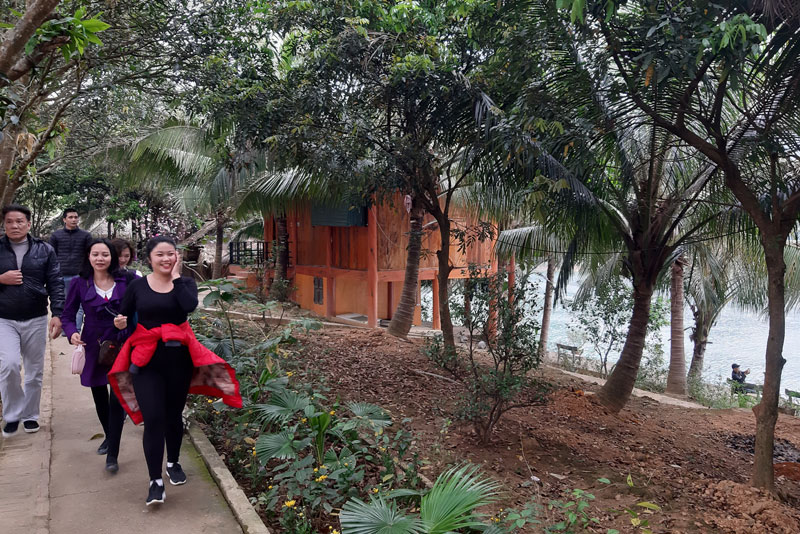
(HBO) - Being one of the five districts and the city located in the development plan of the tourist area within Hoa Binh lake, there are two communes in the lake area Binh Thanh and Thung Nai in Cao Phong district. The scenery in these two areas are charming and the ethnic cultural identity is unique, having great potential for developing different types of tourism within Hoa Binh lake area.
Dua Island is an interesting destination on Hoa Binh Lake, attracting a lot of tourists to visit and experience.
There are a lot of tourist spots bringing great impression to visitors in the district. Thung Nai commune is located in the core zone of the national tourist area within Hoa Binh lake. There are many small islands arranged in the middle of the lake, which is a harmonious combination between the poetic mountains and the clear blue water and clouds. It is considered "Ha Long Bay on land" with a fairyland scene.
Dua Island is one of the most beautiful islands in Hoa Binh Lake area, recognized as a local tourist destination by the People's Committee of the province. Bo Waterfall Cave is located in the relics of the Lord of Bo Waterfall, which is a famous spiritual tourist spot.
The ancient Muong village, Giang Mo, Binh Thanh commune is a famous community tourist destination, attracting a lot of international and domestic tourist groups. Besides, the hamlets and villages along the lake in Cao Phong district such as Tien hamlet, Nai village (Thung Nai commune) are also famous tourist destinations.
Mr. Bui Yen Minh, the officer of Cao Phong Department of Culture and Information says that the district has cooperated with the appropriate departments to review planning, build and implement the solutions to encourage and facilitate the participation of different economic components in tourism development within Hoa Binh lake according to the plan. They have well organized the ground clearance and supported the investors and contractors to implement the construction of road 435 through Binh Thanh commune - Thung Nai. They have also built and improved the capacity of Thung Nai port.
Recently, in coordination with the district, the Department of Culture, Sports and Tourism has made a survey of some points such as Thung Nai port, Ban Tien commune, Thung Nai commune to some tourist sites of Ngoi Hoa commune and some tourist spots within Hoa Binh lake. Depending on the survey, they have been connecting and building tours within Hoa Binh lake.
In the district, many ecological, cultural and spiritual tourist sites such as the cave complex of Dau Rong mountain, Bong Lai temple (Cao Phong town); Vietnamese scientists' heritage park in Bac Phong commune; the tourist spots within Hoa Binh lake have been formed. In the first quarter of 2019, the whole district welcomed 210,317 turns of visitors. The revenue from tourism has reached 15.1 billion VND, of which two-third of the tourists came to tourist spots within Hoa Binh lake.
Hoa Binh has taken measures, focusing on removing barriers in terms of mechanism, policy, infrastructure, and upgrading technical infrastructure facilities serving tourism and the quality of human resources, to promote tourism development in the Hoa Binh Lake area.
Over the past time, Da Bac has deployed measures to lure more domestic and foreign visitors to the locality, aiming to turn tourism into the district’s economic spearhead.
Covering an area of over 52,000 hectares spanning districts of Mai Chau, Tan Lac, Cao Phong, Da Bac, and Hoa Binh City, Hoa Binh lake has strong potential for tourism development. In recent years, thanks to the attention of local Party Committees and authorities as well as support from international organisations, the advantages of tourism in the lake area have been utilised.
Mai Chau is a mountainous district and home to many ethnic groups such as Thai, Muong, Kinh, Mong, Dao, and Tay with distinctive cultural identities, creating a diverse and unique cultural treasure. Aware of its advantages, the district has paid attention to the preservation and promotion of ethnic groups’ cultural values so that culture will become a leverage for tourism and contribute to socio-economic development and life quality improvement.


